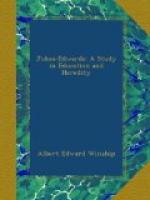In the years of aspiration these children were away from all society life and educational institutions, in the home of a poor missionary family among Indians when Indian wars were a reality. When Mr. Edwards accepted gratefully this mission church his oldest child, a daughter, was twenty-two, his youngest son was less than a year old. All of the boys and three of the girls were under twelve years of age when they went to the Indian village, and all but one were under twenty. When their missionary home was broken up five of them were still under twenty, so that the children’s inheritance was not of wealth, of literary or scholastic environment, or of cultured or advantageous society. Everything tends to show how completely Mr. Edwards’ sons and daughters were left to develop and improve their inheritance of intellectual, moral, and religious aspiration.
In these years Mr. Edwards was writing the works which will make him famous for centuries. One of the daughters married Rev. Aaron Burr, the president of Princeton, then a very small institution. Upon the death of this son-in-law, Mr. Edwards was chosen to succeed him, but while at Princeton, before he had fairly entered upon his duties at the college, he died of smallpox. His widowed daughter, who cared for him, died a few days later leaving two children, and his widow, who came for the grandchildren, soon followed the husband and daughter to the better land.
Mr. Edwards died at fifty-six, and his widow a few weeks later. Both died away from home, for the family was still among the Stockbridge Indians. The oldest son was but twenty, and there were five children younger than he. The youngest son was eight and the other only thirteen. To make the picture more clear it must be understood that to these six orphans, under twenty-one, there came at the time of their father’s and mother’s deaths two little orphans aged four and two respectively, Sarah Burr and her brother Aaron. Here was a large family from which father and mother, older sister and brother-in-law had been taken almost at a single blow, with two extra orphans to care for.
And with all this there was no adequate financial inheritance. The inventory of Jonathan Edwards’ property is interesting. Among the live stock, which included horses and cows, was a slave upon whom a moderate value was placed. The slave was named Titus, and he was rated under “quick stock” and not “live stock,” at a value of $150. The silver was inventoried as a tankard valued at $60, a can and porringer at $47, and various other articles valued at $85. The chief material legacy was his library, which was inventoried as consisting of 301 volumes, 536 pamphlets, forty-eight maps, thirty unpublished manuscripts and 1,074 manuscript sermons prepared for the printer. It was valued at $415.




